Saturday 25th April 2020
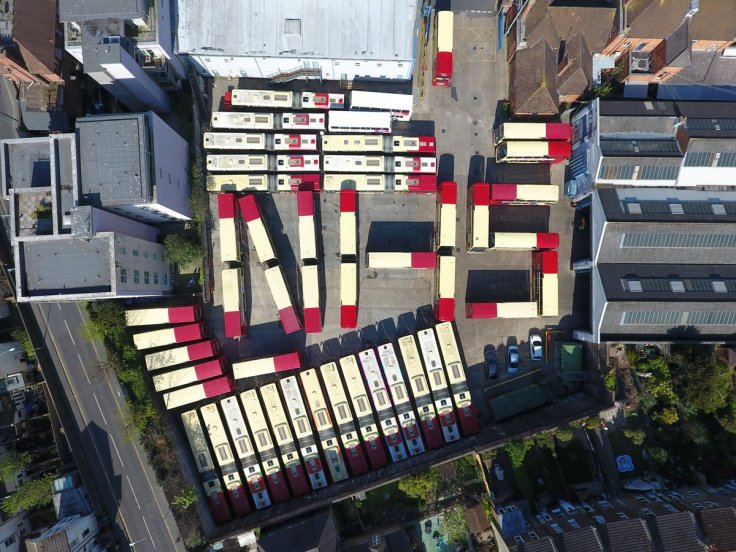
Lockdown Week 5 will soon be over and done with and there’s a definite air of the new ‘normal’ becoming normalised. I’ve become unnervingly accustomed to seeing empty buses sauntering along traffic free roads and trains gliding along the tracks carrying fresh air and not thinking it won’t be long before these little used journeys are cut back “to save costs”. It’s something of a luxury to not worry about empty buses and trains thanks to the all new and welcome “whatever it takes” Government financial support. Except, we all know it won’t and can’t last.
You can also tell things are settling down with social media channels sporting a welter of amusing distractions dreamt up by low-pressed tweeters unaccustomed to having so much time on their hands. I know most of these distractions are hilarious to many; and I may be suffering from a humour by-pass, but it seems to me some of the non-furloughed-remaining-on-full-pay train company tweeters might be better occupied reading a book than thinking they’re reality show entertainers. Last week saw LNER’s twitter team spend the best part of a day running a Who Wants To Be A Millionaire style quiz (since deleted from their timeline) while other TOCs are filming and uploading dancing staff aiming to outdo each other by challenging a fellow TOC. This is not a Strictly Come Dancing entertainment interlude. This is a tax-payer fully funded railway carrying vitually no one and with all staff’s wages paid for by the public. Rant over.

On a brighter note and following GTR’s lead. reported last time. more dignified and ever more novel NHS tributes have been appearing across fleets over the last week. Not least the rather clever bus parking arrangement overseen by Brighton & Hove’s Lewes Road bus garage supervisor Lee Weir last weekend and captured by drone (see lead photo above).
You can always tell a good idea because as sure as ‘ramping up’, ‘guided by the science’ and ‘flattening the curve’ appear in every Number Ten Coronavirus press conference Bingo card, so you’d just know similar bus parking variations would soon be circulating across social media; and it wasn’t long before East Yorkshire and Stagecoach’s Elgin garage joined in the vehicle manoeuvring fun for the NHS clapathon on Thursday.
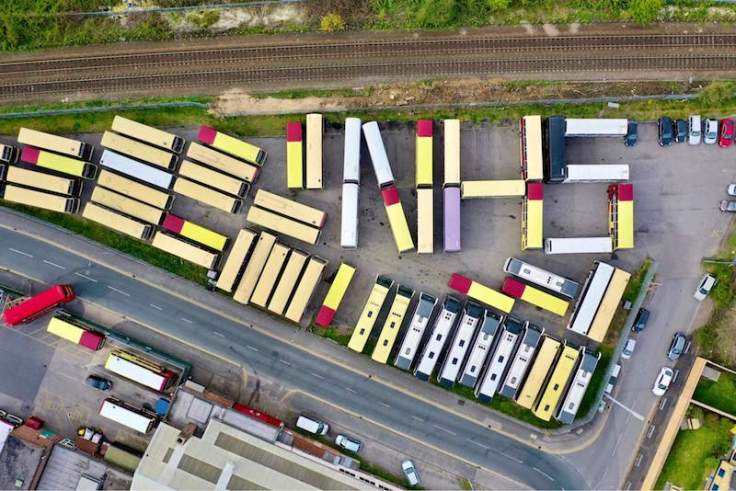
Stagecoach even posted a video of the pre display manoeuvring captured by their drone on YouTube. Worth a quick look here.
Over in Keighley a special bus was named in honour of the town’s new local born national hero Captain Tom Moore; what would anyone give to have chart topping Tom as an ambassador and fundraiser for their industry? What a truly fantastic man. Wonder if he likes buses?!
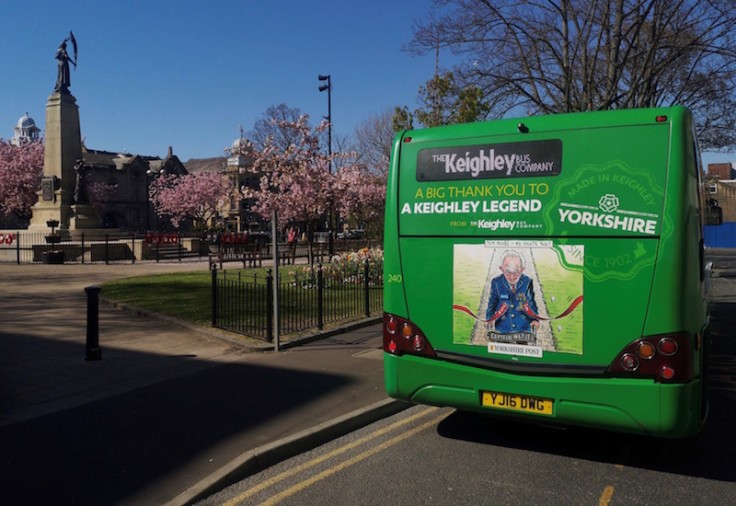
Sister company Harrogate Bus Company extended the thanks theme further by adding photographs of locally based key worker staff (Harrogate heroes) to the side of a bus making for a great community link.

Meanwhile on the trains Northern followed GTR’s lead by adorning four trains including 195111 with an NHS supportive message and it can’t be long before other class fleet numbers ending 111 around the country follow in the same tracks.

Service reductions seem to have reached their nadir now. You might think Cross Country are doing some sensible pruning from this Monday by reducing the extreme ends of its hourly cross country routes to a more sensible two-hourly frequency. This effects south of Reading to Bournemouth; south of Bristol to Plymouth (Penzance was culled weeks ago); north of Newcastle-upon-Tyne to Edinburgh; east of Leicester to Cambridge (Stansted was culled weeks ago); west of Birmingham (from Nottingham) to Cardiff.
However over on LNER’s website are details of a stepping up of the East Coast Main Line service from the previously operated two-hourly London to Edinburgh increasing to hourly (thus compensating for the Cross Country cutback north of York) by extending its perviously two-hourly journeys terminating in York on to Edinburgh. Am I alone in thinking the frequencies being run on the railway are still far too generous for the reported 5% of passengers travelling, particularly on long distance routes which surely can’t be accommodating many, if any, essential workers who I would guess mostly work locally?
Not previously recorded on these blogpost updates are reductions on the Arriva owned Yorkshire Tiger network of ‘Flying Tiger’ branded routes serving Leeds Bradford Airport. From Sunday 19th April route 757 (Leeds to the Airport) ceased operating completely with route 737 (Bradford to the Airport) terminating short at Yeadon while route 747 (Harrogate to Bradford) continues but not serving the airport. All very sensible, and although Yorkshire Tiger’s home webpage summarises these changes, it’s a bit confusing that pre-Covid timetables are still on display when clicking on the Timetables tab.
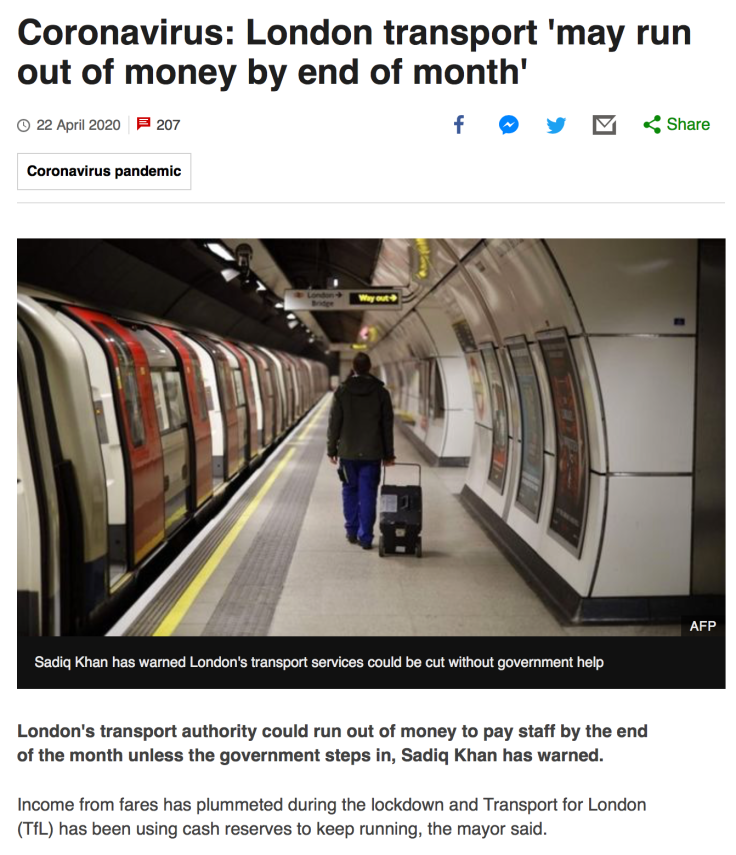
Back in London the implications of making all bus travel free have not surprisingly soon became financially obvious with Mayor Khan making the point TfL will run out of cash next week unless the Government throws it a bail out lifeline. Sources tell me DfT mandarins were distinctly unimpressed with the free fares policy being introduced seeing it as the Mayor’s mistaken knee jerk reaction to Unite the Union’s pressure following their understandable concerns at the number of bus driver deaths. Outside of London every other bus company continues to charge fares, albeit some have moved to an exact fare policy without drivers handling the cash as well as heavily promoting use of contactless. Go North West launched a small tray for passengers to use to hand cash over to the driver which looked a neat solution.

Over at Ensign Bus the team issued a statement on Monday as “a number of of people have asked if we are going to follow TfL London Buses and only allow centre door boarding and have free travel for everyone”. In a characteristic straight talking response the company pointed out they only have front doors; from early on hand sanitisers were installed on buses, protective gloves and face masks provided to all staff with protective screens and social distancing. The response went on to explain “we rely on fares revenue for our services to survive; we cannot just say everything is now free”, pointing out London buses are part funded by the taxpayer and other means. “It’s a bit like saying to a supermarket all food should be free”.
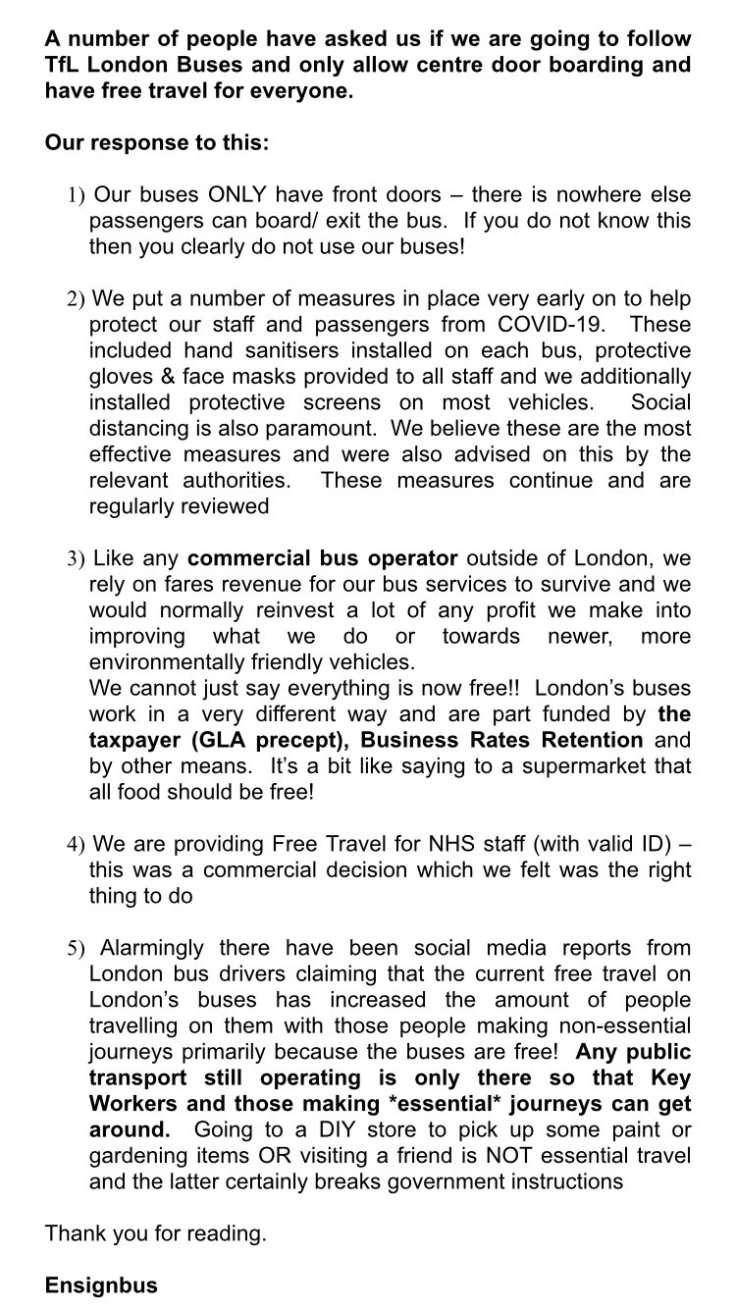
Interestingly Ensign’s statement went on to say “alarmingly there have been social media reports from London bus drivers claiming current free travel has increased the amount of people travelling on them with people making non-essential journeys because the buses are free”.
And at the daily Number 10 Coronavirus Press Briefings the travel graph now shows TfL bus use stopped as at 19 April as presumably no-one has any idea how many people are travelling as recording ceased with everyone piling on and off for free through the centre door.

It’s not going to be easy to exit this free fares strategy. Good luck with that one Sadiq. It looks like the unions may well be the new ‘influencers’ in the Capital as there were also reports on Tuesday (BBC London’s Tom Edwards tweeting) “sources say new interim tube timeables due to start on Sunday has been postponed for a week. Unions rejected it as unsafe”.

Meanwhile TfL announced on Friday it was furloughing a quarter of its 28,000 staff – and that number doesn’t include any staff working for the contracted bus companies of course. It does make you wonder why it’s taken so long, what they’ve been doing for the last five weeks and what the other 21,000 staff not being furloughed are doing now.
Earlier in the week the Urban Transport Group on behalf of tram and light rail operators called on the Government to provide assistance for their ailing finances. Mayor Burnham was reported as saying he’d have to mothball Manchester’s Metrolink without a timely bail out; which actually might not be a bad idea for some of that network. I can’t believe the new 5.5 km extension to the Intu owned Trafford Centre was introduced the day before lockdown on Sunday 22 March and would be amazed if it’s carrying anyone. Unbelievably it’s being promoted online even now!
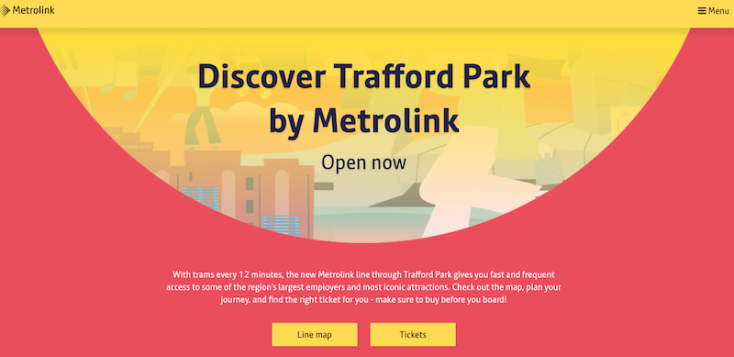
Grant Shapps drew the short straw of turning up at the daily press conference on Friday which was an opportunity to let it be known a rescue package would indeed be heading towards the tram operators but interestingly no word in the announcement about Croydon (nor aiding TfL more generally) or Blackpool (and Edinburgh, albeit that comes under Transport Scotland’s juridisction).
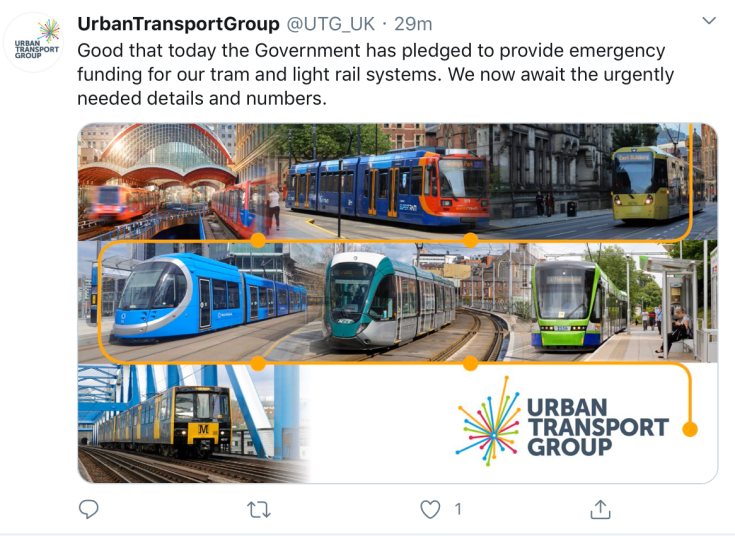
There’s no doubt Government funding is going to be necessary across all public transport modes for some considerable time ahead. A poll released today from consultancy Systra suggests commuters using buses and the Underground in London “could fall by as much as 40% from pre-lockdown levels” with “rail use dropping by 27%” although there’s no background information indicating the ‘scientific validity’ of the poll.
The biggest unresolved issue for post lockdown public transport still remains how on earth social distancing measures can apply on buses, trains, Underground and trams once travel restrictions begin to be lifted. Realistically keeping a 2 metre distance is not possible without a significant reduction in capacity (and its economic consequences, let alone availability of vehicles) and just at a time when public transport availability will be crucial to avoid a return to extensive car use, congestion and air pollution.
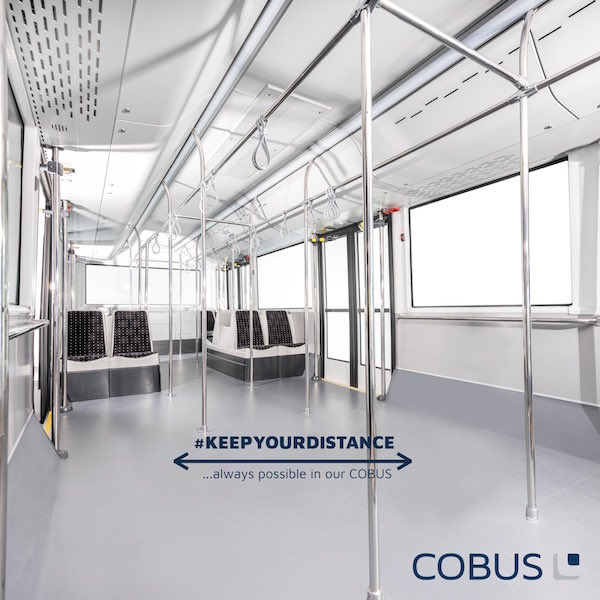
Measures will be needed to ‘suppress the peak’ (for travel, not ICU bed occupation) by encouraging workplaces to stagger their operational times so employees can travel to and from work at quieter times. This could also be encouraged by transport operators offering price incentives; e.g. attractive fare reductions for travel pre 07:30. School attendances may also need to be staggered and, for sure, we’re all going to be wearing face masks when using public transport, so get the sewing kit out of that multi purpose drawer in the kitchen now.
There also needs to be a balance between those high-viz, yellow and black security style, safety shouty-at-you notices aimed at instructing passengers to the new Covid-19 coping way of behaviour and offering a warm friendly welcome to the attractive world of public transport travel.

The Confederation of Passenger Transport (CPT) updated its members on Friday including news of its Back Britain’s Coaches campaign. It’s good to see 300 coach companies responded to CPT’s request for details of coach ‘mothball’ costs so a case can be put for support over the medium term. A few coach companies have got together to produce a nice little five minute video explaining the challenges. You can view it here. There’s no doubt coach companies are really up against it and more company failures will sadly surely be in the news during the next few weeks.
My other highlight of the week was receiving another update letter from the CEO of Stagecoach, Martin Griffiths which was nice of him – I haven’t heard anything from the CEOs of Arriva and First even though I must have handed over my email address a multitude of times when signing in to use their onboard wifi – I’m guessing that’s how Martin has contacted me!
Martin courteously “would like to take this opportunity to thank you for your part in helping us to keep operating our vital bus services safety to protect our customers and our drivers, ensuring we contribute to get key workers to their jobs and help people to shop for essentials”. Which is all very nice, but I’m not sure what I’ve done to deserve such thanks; other than stay at home. The letter goes on to tell me about the way “heroes behind the wheel” are also helping in communities with grocery shopping among other things as well as running shuttles for NHS staff and additional services to food production sites and distribution centres. All good PR stuff I guess.
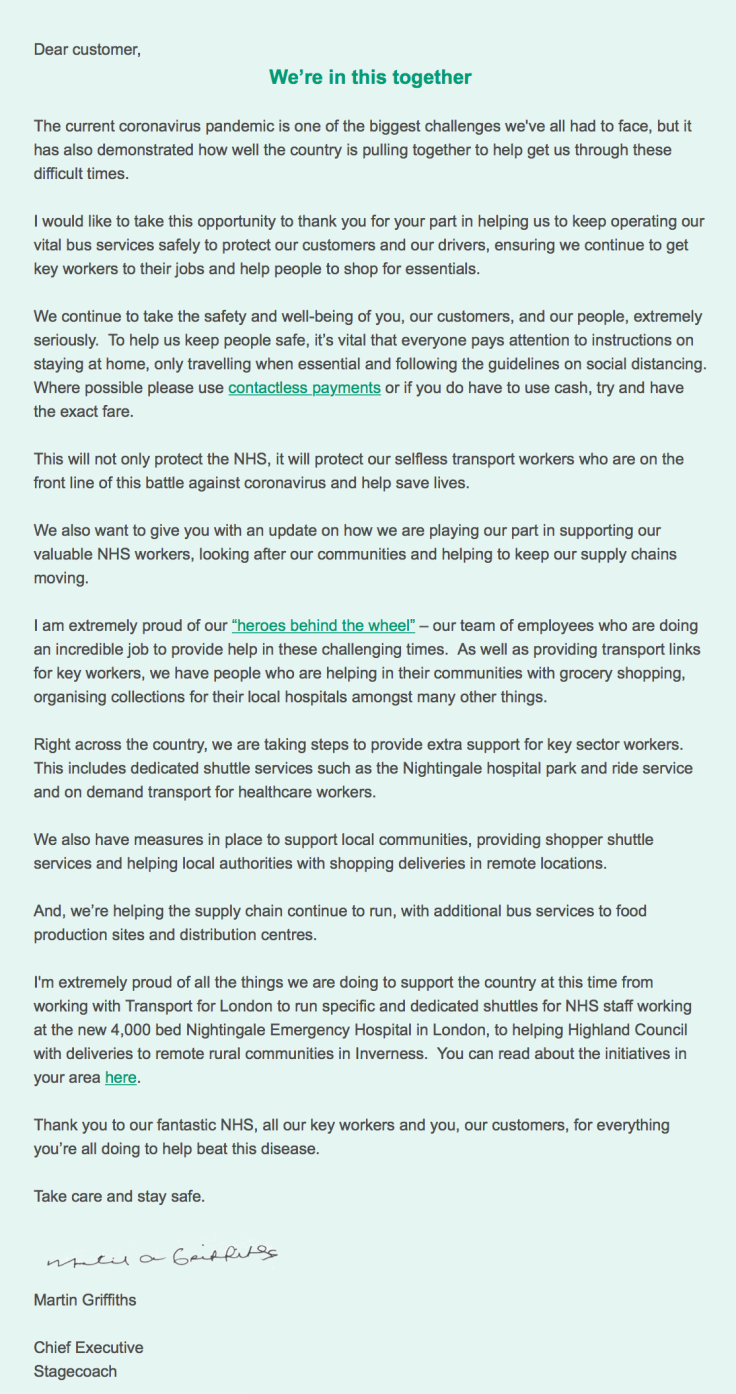
Finally, in other news this week it was interesting to read South Western Railway’s Class 707 trains will be offloaded on to southeastern as part of a leasing deal between the two TOCs. Presumably the deal follows the recently announced award of a contract extension to southeastern. The 30 5-car units had been ordered by South West Trains and only entered service in 2017, just at the same time as new franchise holder SWR decided to get shot of them in favour of brand new Bombardier Aventra class 701 trains instead. Such is the Alice in Wonderland world of train fleet procurement. Speculation is the non-toilet equipped 707s will be used on ‘metro’ type services such as the Hayes line.

As a twist on the bus parking drone photo, I’ll leave you with Go North East’s NHS tribute from its Deptford garage on Thursday.
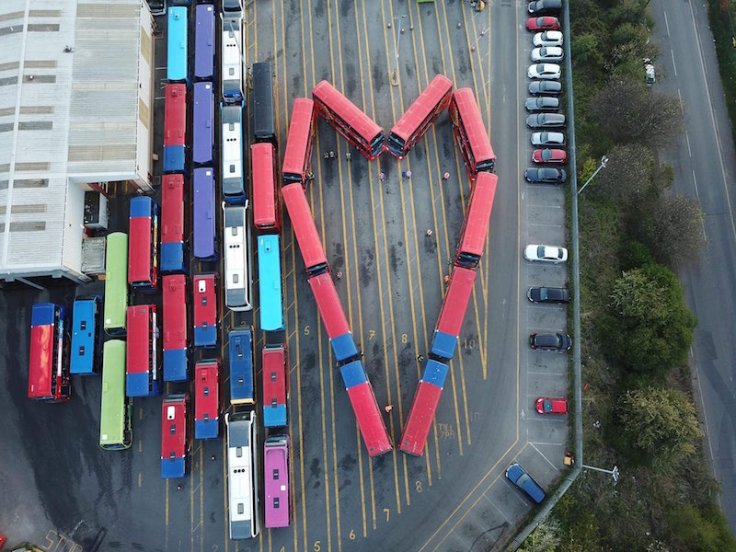
Lockdown Week 6 beckons.
Roger French


Blackpool tram assistance may have been omitted as the tram service has ceased running. The parallel service 1 bus has been enhanced to compensate.
LikeLiked by 1 person
Ah; of course that would explain it. Many thanks.
LikeLike
Regarding your comments about railway social media use, let’s just say that not all staff are happy with what’s going on.
In particular there’s discontent that managers at certain “social media friendly” TOCs are happy to allow their social media teams (and certain favoured staff) to daily breach the companies’ social media and professional behaviour policies (amongst others) at the same time as they’re jumping down the throats of other staff for social media posts which don’t even begin to breach those policies. The only reason it won’t ever blow up into a national dispute is that none of the unions understand social media.
There’s a definite disconnect between the world of the social media teams, who I guess are mostly twenty-something recent graduates, with their daily attempts to make everything happy and bouncy and fun and the reality of ground level railway where, to be honest, most passengers are there only because they have to be and aren’t particularly enjoying the experience. Following the twitter feeds (in particular) you can often sense the social media teams playfulness rubbing up against passengers who simply don’t find them amusing, and it’s noticeable how unprofessionally they respond if one of their pet staff receives a complaint; EMT, for example, were well known for responding aggressively to any complaints about their favourite train manager’s PA antics.
LikeLiked by 1 person
While I haven’t waded through all 182 pages of TfL’s most recent annual report, there seems to be precious little information on how those 28000 people are split across TfL’s different businesses, but it is a very, very large number – broadly equivalent to the whole of the Go-Ahead Group.
What the report does reveal is that around half earn £50,000 or more, considerably in excess of national mean salaries and generous, even taking London living costs into account. Surely some of them could get by on 80% for a while, saving the public purse a good few pennies along the way.
LikeLiked by 1 person
You have certainly high-lighted the appalling dilemma that public transport in all forms will soon face as lockdown restrictions are eased. As I have previously pointed out, for many, travel will simply be seen as “Unsafe”. Period. I think it was reported in one of the trade magazines (Passenger Transport?) just this week how the Society of Motor Manufactures are rubbing their hands with glee, as a poll has shown almost 45% of “youngsters in urban areas” (viz London!) are now considering for the first time buying a vehicle. Just pause for a moment and recall what traffic conditions were like before the Chinese virus came, and try and imagine the future…….! And I do so hope we do all have to wear masks, as it just might stop some of us having to listen to inane, loud and usually ridiculous mobile phone conversations when travelling. And my thoughts on the misuse of Twitter and Social media in general are quite unprintable, and some of the cringeworthy things I cannot fail to see even when not looking, do absolutely nothing to amuse me.
LikeLiked by 1 person
Now that (muted mobile phone conversations) is a real upside of mask wearing …. unless it makes some prats talk even louder into their devices!
LikeLike
“I can’t believe the new 5.5 km extension to the Intu owned Trafford Centre was introduced the day before lockdown on Sunday 22 March and would be amazed if it’s carrying anyone”
The Trafford Centre line runs through the centre of Trafford Park which is home to 1,300 business employing 34,000 of people in companies such as Kelloggs, Unilever, L’Oreal, Adidas, Procter & Gamble, Amazon to name just a small number. Pre-lockdown Stagecoach 250 service ran approx every 7 minutes, now every 30 mins which suggest demand even in the current times.
LikeLiked by 1 person
You’re wondering what the 28,000 TFL staff do… certainly on the bus side, so am I!!
They’ve implemented the ridiculous travel free policy, with no manual logging, so the situation is they still have VERY many routes running vastly over provisioned Saturday services, and bosses now absolutely no idea how many, or few, are using them. Those routes that HAVE switched to Sunday services are in a lot of cases still vastly over bused, but with the added disadvantage of a later start up time.
As an example, despite highlighting the problem to TFL some 4 weeks ago, the 208 runs every 15 mins all day (Sunday service with a late start), followed by the N199 every 30 mins (on a weeknight service with an early finish), which then leaves a 2 hour gap with no buses at all arriving at Lewisham hospital from Orpington or Bromley etc between 04:30 and 06:30, just when some on the early shift need to get there!! Brilliant!
A few routes have very sensibly implemented a hybrid of low level of service all day but with early starts and enhancements in the morning peak, but what arrangements are being made for the other 700 plus services? I realise it’s a big job to get the computer to crunch the schedules, but how long does it take…?
London Passengers have had to find alternatives and quickly because of need, and once new habits become formed, they may not go back to the old slow and dirty buses with drivers for whom having to stop and pick up passengers is such an inconvenience in their day.
LikeLiked by 1 person
The future does look different in many respects.
If I was the Society of Motor Manufacturers and Traders, I wouldn’t be cracking open the bubbly. A massive reality check is about to hit. On the one hand massive redundancies as businesses collapse – the signs from the High Street with the likes of Debenhams going into administration suggest tens of thousands of job losses are on their way. On the other, the simple fact that if young people cannot afford to buy a house or flat to live in, how can they afford to run a car? That 54% won’t be rushing to the car showrooms, they’ll be going to Uber instead. If they’ve got a job.
There is also the discovery that many jobs in the office and professional sector, which previously required employees to commute in and out everyday, with the staff needing to access files of records, documents and papers held in office blocks in city centres or business parks can now be done at home with everything needed accessed online. Managers who had resisted home working believing productivity would suffer are having to get people working from their home computer, or are ordering laptops by the thousand to keep their business operating. Pre COVID, those of us who travel by bus and train as commuters have noticed that Friday rush hours tended to be quieter; services that normally would be standing room only had plenty of seats available. Friday, for those that could, tended to be “home work” day.
The bus indsutry could be considered to be the canary in the coal mine, a bellwether of things to come. The thinning of the network has been caused by societal changes. The trips to the town centres by people to do their shopping or banking have reduced, people are shopping and banking over the internet instead. The changes will accelerate in the post COVID world. The collapse in patronage in lockdown suggests many trips are discretionary; are they, with some of the offie commuters gone, never to return?
The industry has also got to be prepared for a sustained period of negative “buses and trains are unsafe” coverage from the media. In the West Midlands this is well known. Despite a dedicated “Safer Travel” police team the local papers regularly feature stories about miscreants on buses and trains with stuff pulled from social media, but unsurprisingly there is little effort to report them when they end up in court and are sentenced, because that might involve travel, journalism, effort and work. “Buses are unsafe” with a picture lifted from Facebook and comments cut and pasted sells papers or generates clicks for ad revenue; “Pickpocket gang nabbed after being caught by bus inspectors” after a trip to the depot and Crown Court does not.
The worry is if passengers don’t observe social distancing once lockdown eases, or operators don’t up services to meet demand as people start to go out again the tabloids and local rags will have the headlines ready. You’ve only got to see what happened when TfL cut tube services early on in the lockdown with television programmes and Twitter showing tubes still packed as people still needed to go to work.
To deal with this, and the situation that when frequencies are upped capacity will be halved due to social distancing another “reality check” is needed. The free travel scheme on buses needs to be revised for post lockdown. In order to ensure that commuters and key workers can get a seat in the evening rush hour, on weekdays it should be limited to operate between 9.30 and 15.30 only. Operators may need to review fares, look at limiting off peak ticket validity and reverting back to pricing based on distance travelled (many now having gone to flat fares or area tickets). Not great for passengers, but perhaps the only way to ensure sufficient revenue is coming in to keep the show on the road, as it were. Better there is a bus there albeit with a higher fare, than no bus at all.
LikeLiked by 1 person
I’d like to comment on two things.
First, the ‘survey’ by Systra. This has no value except as a name-recognition exercise by a consultant with nothing else to do. The ‘scientific validity’ is not explained anywhere that I can find, it looks like they’ve just emailed a bunch of people and asked them what they think they’ll do in the future – it might be an interesting exercise in psychological monitoring but as a useful piece of information for the future of public transport in Britain, nothing. Best ignored, along with all the other armchair pundits who bang on about how things will pan out post-epidemic. The truth is that no-one knows and the people to pay most attention to are the ones who start by admitting that. Transport planners across the country will be looking at a whole range of possibilities and thinking about how to influence the future, at the same time as worrying about their own families in the here and now. Wish them luck.
Second, I was taken aback by the tone of the article and some of the subsequent comments when discussing bus drivers. People are dying – 20 London bus workers already have. They may continue to die and how anyone can complain about TfL or any other operator for trying to do something about that beggars belief. Explain it to the families of those who’ve died or the families of their colleagues. At this time, if saying something positive is proving impossible then a dignified silence would be more appropriate than throwing rocks. We can have a robust and respectful discussion later on, when we’re all through this.
LikeLike
Where staff are furloughed, or are still employed but don’t have as much to do as they normally would because there’s not much happening, why shouldn’t they have a bit of fun? It doesn’t cost the employer any more if they are sitting in a corner reading a book or trying to keep their spirits up and put a smile on the faces of some of the public at the same time.
LikeLike
Nothing much to add, except that you have hit several nails on the head.
I worry that many of the public have been so frightened by the incessant Government propaganda and BBC news that buses and trains will take a long time to fill up even if everyone has been tested and is allowed to travel. Using cars is worse for the environment. Also if over 70s or 80s, or 60s, are banned from travelling there will be a revolt. I am surprised the young [ie non-pensioners] have not already protested against the collapse of their whole world. But the fit old, who often do volunteering jobs themselves, and/or with fewer years left in which they can be active, may be less tolerant of future restrictions.
I hate the thought of not being able to hop on buses around the country for 12 months, not just 3 , but rally goers and heritage railway visitors, and many other hobbyists, have lost their entire lives. Lets hope vaccination comes quickly.
All credit to Stagecoach our local operator for carrying on, every 2 hours, but can I travel even to Aldershot and back? Yes for hospital appointments, but they have all been cancelled despite empty beds, doctors’ surgeries, etc.
LikeLike
I think a large portion of the 28 000 TfL employees will be the directly employed LUL operational workforce. I think about 11 000 operations and another 5 000 engineers, maybe more. The balance will be the head office types. I’d like to defend TfL. The W3 where I live is no busier since the centre doors boarding policy than before, about 2 people per trip where it passes me in Crouch End. I’m not using it at the moment but I’m glad it’s there. It’s running a Sunday service spot on time – if only it can keep that up. Someone said their buses are dirty. Don’t agree and the windows are always much cleaner than the provincial outfits.
Look this is going to be very difficult for everyone. Commercial norms are out of the window and even in this government I think the sensible ones recognise this. Professional bus people around the country will have to be asked to draw up sensible joint networks with integrated ticketing and information and coordinated timetables and the taxpayer will have to fund them.
LikeLike
One of your correspondents commented about the seeming over-provision of service frequencies in TfL-land, and the need to tailor schedules to demand more closely. There are two points here . . . .
1. It’s not necessarily about meeting demand, but more to do with meeting expectations. London bus passengers have become used to a turn-up-and-go frequency on 90%+ of bus routes (whether that’s right or not is for another debate). It is proven that passengers view 5 BPH as TUAG; anything less means “waiting for ever for a bus”!! In London, one of the rationales for service frequency is to reduce car use . . . . in general that would have been successful if not for the 10% increase in population over the last 20 years, and the desire for people outside London to continue to drive instead of using trains or coaches.
Those bus routes that were (quickly) reduced to a Sunday schedule every day often had a supplementary schedule overlaid in the AM Peak to meet perceived peak demands. We are now seeing routes re-scheduled to provide 4 BPH from weekday first to last bus times, which is a good compromise between service frequency and demand, bearing in mind social distancing.
2. Of the 700 or so bus routes, probably 100 are night bus routes, so need no re-scheduling (drop to weeknight schedules . . . job done). That leaves 600 routes; probably 100 of those need no further tinkering with, as they already operate below 4 BPH. So . . . . 500 routes left to re-schedule. In order to make “Countdown” to work, there has to be a lead time of (usually) 3 weeks. That has been cut to around 7 working days now for the big super-cruncher computers to have data entered, checked, verified, and eventually filtered down to the bus stops, so the passenger sees real-time information, not best guesses.
Before that, the schedule needs to be compiled . . . . in round terms, one daily schedule for one route takes one day to compile, taking care to meet the various specifications that TfL sets out for the route, and also what the operator is measured against financially on the contract. There are probably about 35 schedule compilers in London (and we’re all working pretty much flat out!!), so 35 routes per day . . . 500 routes to compile . . . . that’s about 3 weeks (assuming nothing else interferes with the process!). We’re doing our best, Guv!!!!!
I’ll also just make the point that drivers are entitled to 3 weeks’ notice of changes to shift patterns; they’re waiving that right at present; generally on a Wednesday they’ll find out their times for Saturday and the following week. In the background are the duty allocation supremos; they’re always forgotten, but they normally work 2 weeks in advance, and are now working 4 days in advance.
So . . . . “surely the computer can do it?”. There’s an awful lot going on in the background!!
Right . . . . another route summons me . . . .
LikeLiked by 1 person
Quite why the trams are starting sdo early and finishing so late and run so frequently who knows> The number of passengers are low. They could even look at suspending the tram service and replacing it with buses. It would save a fortune
The same could be done on some short branch railway lines. Many have more staff than passengers at present
LikeLike
Buses facing a bleak Future
Reports are suggesting that Post Covid buses face up to a 25% permeant drop in passengers , The 25% is presumably wort case but a 5% to 10% drop in passenger numbers is highly likely. Far more people will be working from home and there has also been a big switch to Online shopping meaning fewer high street trips. There will also be a significant drop in air travel meaning fewer passengers travelling to airports by bus. Some of the small regional airports may never even re open
THe exact drop in bus passenger numbers will be hard to tell but their is no doubt in my view that it will be significant and a drop of that sort of level is likely to turn a lot of the routes outside of the large towns and cities into lossmaking. If you take GO Aheads East of England operations all those companies are already loss making. It will be interesting times. A number of the smaller bus companies may never restart services
LikeLike
Just a quick couple of comments here . . . . .
If bus companies received FULL fuel duty rebate on their diesel, the economics of running a bus service would change drastically. Railways and airlines pay no fuel duty, so why should buses? I wonder how much that would actually cost the Treasury?
{Current fuel duty = 58p/litre; BSOG = 33p/litre (I think, but will be happy to be corrected)). That 25p/litre reduces fuel bills by 40% . . . . a huge difference, given that a Euro6 bus will barely manage 5 mpg in London, or 8 mpg in the shires).
Agreed in re the fragility of some operators . . . . a few have already given up, and there will be more that simply don’t re-start services.
This is going to be the biggest change in the bus industry for . . . . well, for ever. The disruptions of the 1930 Transport Act; the 1970 Transport Act and the 1985 Transport Act will be as nothing compared to post-C19. {Unless Government step up and actually integrate, of course, but I’m not holding my breath . . . . . }.
LikeLike
I very much appreciate the interesting insight provided by greenline727 into a number of aspects of the creaking operations of the behemoth that is TFL… I’m sure there’s plenty of amusing anecdotes or tear-your-hair-out moments being had there, maybe we could meet up and…. oh no, hold on a minute!!
Also interesting to note that despite 4 weeks of getting nowhere with the official channels, those extra 208 journeys are now showing on the TFL journey planner less than 48 hours after the 2 hour gap being highlighted in this blog! …. shurely shum kind of coincidence Mr Bond!!
Of course they MAY have been actually running for some time, but without showing up on the journey planner or ibis/countdown, nobody would be likely to stand at the bus stop at 04:45 just on the offchance, so they wouldn’t have been any use to anyone anyway!!
LikeLike
Absolutely, single deck buses with front third sealed off, passenger numbers on the increase with free travel and all in and out the bus via one door -NO CHANCE FOR social distancing
Same on the tube and trains too no revenue no passenger numbers recorded if ticket barriers are not in use or enforced… of course FIGURES will show less travel…
Interestingly Ensign’s statement went on to say “alarmingly there have been social media reports from London bus drivers claiming current free travel has increased the amount of people travelling on them with people making non-essential journeys because the buses are free”.
And at the daily Number 10 Coronavirus Press Briefings the travel graph now shows TfL bus use stopped as at 19 April as presumably no-one has any idea how many people are travelling as recording ceased with everyone piling on and off for free through the centre door.
LikeLike